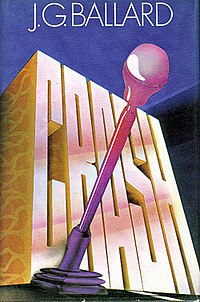| Revision as of 01:09, 2 May 2018 editEspngeek (talk | contribs)Extended confirmed users70,133 edits →External links← Previous edit | Revision as of 01:09, 2 May 2018 edit undoEspngeek (talk | contribs)Extended confirmed users70,133 edits →External linksNext edit → | ||
| Line 67: | Line 67: | ||
| ] | ] | ||
| ] | ] | ||
| ] | ] | ||
Revision as of 01:09, 2 May 2018
| This article needs additional citations for verification. Please help improve this article by adding citations to reliable sources. Unsourced material may be challenged and removed. Find sources: "Crash" Ballard novel – news · newspapers · books · scholar · JSTOR (August 2009) (Learn how and when to remove this message) |
 Cover of first edition (hardcover) Cover of first edition (hardcover) | |
| Author | J. G. Ballard |
|---|---|
| Language | English |
| Genre | Postmodern novel, Transgressive fiction |
| Publisher | Jonathan Cape |
| Publication date | June 1973 |
| Publication place | United Kingdom |
| Media type | Print (Hardcover & Paperback) |
| Pages | 322 |
| ISBN | 0-224-00782-3 |
| OCLC | 797233 |
| Dewey Decimal | 823/.9/14 |
| LC Class | PZ4.B1893 Cp PR6052.A46 |
| Preceded by | The Atrocity Exhibition |
| Followed by | Concrete Island |
Crash is a novel by English author J. G. Ballard, first published in 1973. It is a story about symphorophilia; specifically car-crash sexual fetishism: its protagonists become sexually aroused by staging and participating in real car-crashes.
It was a highly controversial novel: one publisher's reader returned the verdict "This author is beyond psychiatric help. Do Not Publish!" In 1996, the novel was made into a film of the same name by David Cronenberg.
Plot summary
The story is told through the eyes of narrator James Ballard, named after the author himself, but it centers on the sinister figure of Dr. Robert Vaughan, a "former TV-scientist, turned nightmare angel of the expressways". Ballard meets Vaughan after being involved in a car accident himself near London Airport. Gathering around Vaughan is a group of alienated people, all of them former crash victims, who follow him in his pursuit to re-enact the crashes of celebrities and experience what the narrator calls "a new sexuality, born from a perverse technology". Vaughan's ultimate fantasy is to die in a head-on collision with movie star Elizabeth Taylor.
References in popular art
Music
The Normal's 1978 song "Warm Leatherette" was inspired by the novel, as was "Miss the Girl," a 1983 single by The Creatures. The Manic Street Preachers' song "Mausoleum" from 1994's The Holy Bible contains the famous Ballard quote about his reasons for writing the book, "I wanted to rub the human face in its own vomit. I wanted to force it to look in the mirror."
The singer Glenn Danzig sings about this in his band Samhain's song "Kiss Of Steel" on the album "November-Coming-Fire"
Film
An apparently unauthorized adaptation of Crash called Nightmare Angel was filmed in 1986 by Susan Emerling and Zoe Beloff. This short film bears the credit "Inspired by J.G. Ballard."
See also
References
- Lars Svendsen, A Philosophy of Boredom, trans. John Irons (London: Reaktion Books, 2005), 82.
- https://www.theguardian.com/books/2009/apr/20/jg-ballard-film-music-architecture-tv
- Taylor, Brett (Oct–Nov 2009). "The Forgotten Crash: Nightmare Angel". Video Watchdog (152): 12–16.
External links
- The Terminal Collection: JG Ballard First Editions
- Crash at the British Library